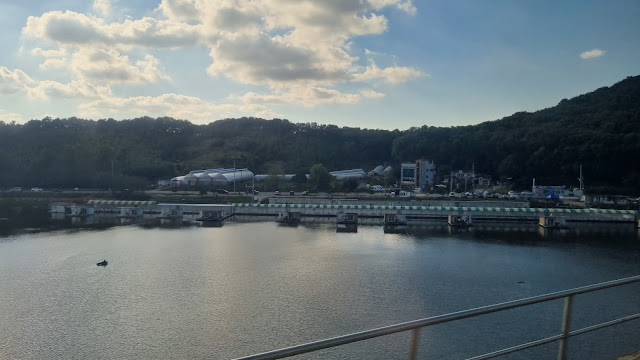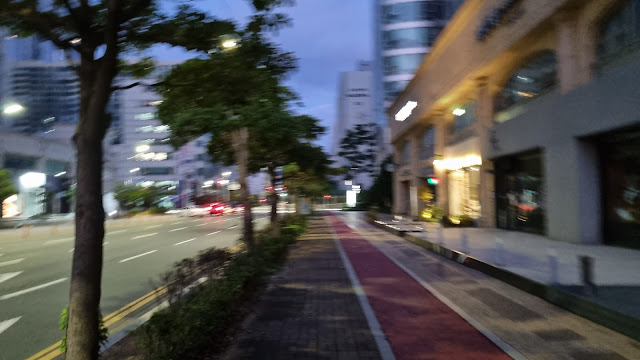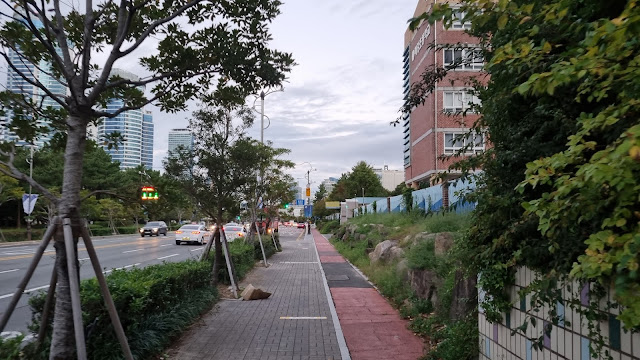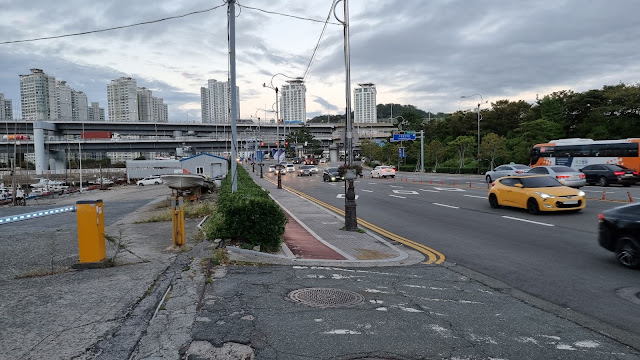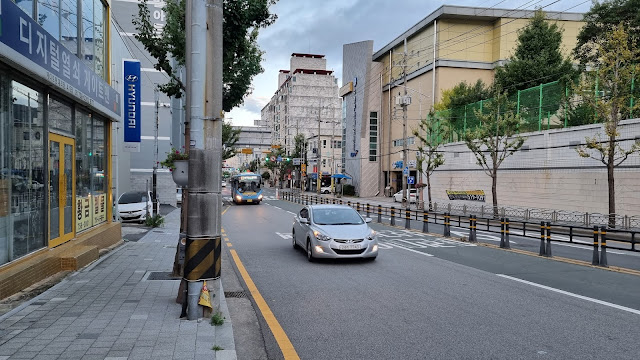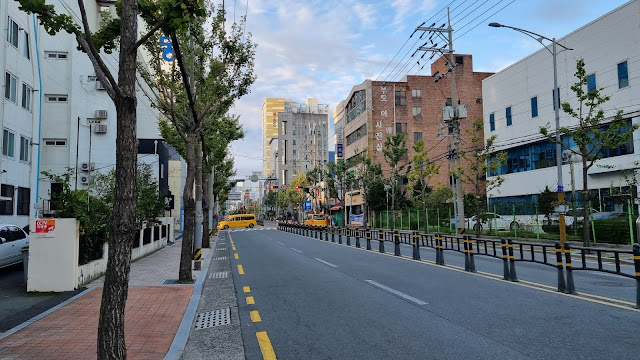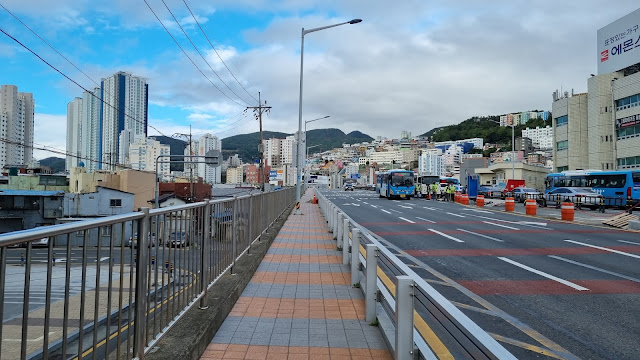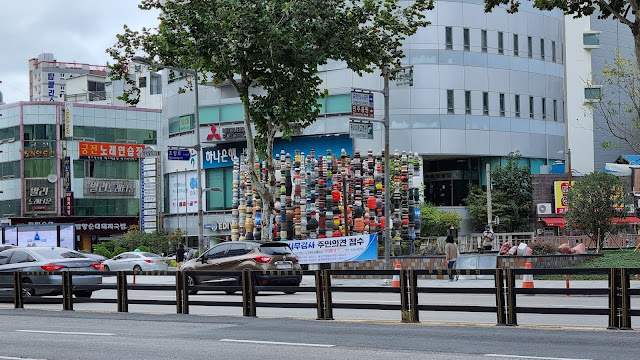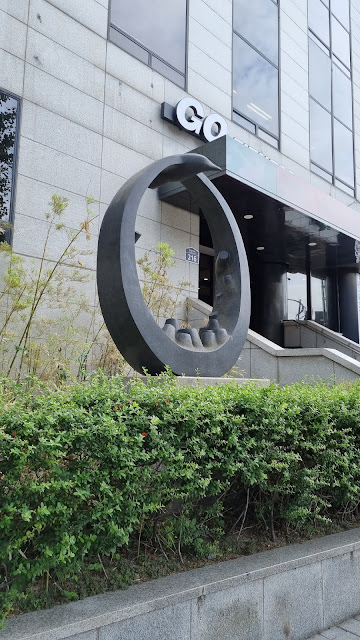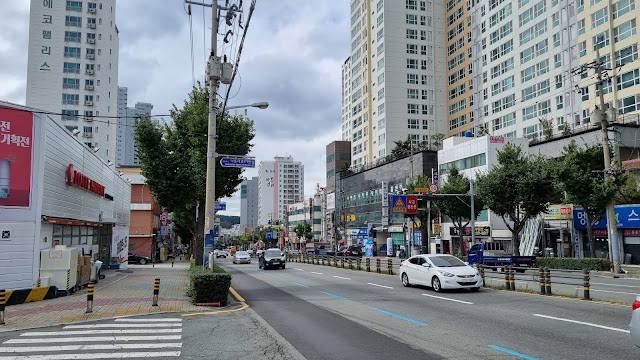[WARNING: very long. Get coffee or tea or a strong drink.]
So! The latest walk is over, and I'm back in Seoul after a 2.5-hour KTX ride north from Busan. Now, while I'm happily digesting a burger (tried to order Papa John's pizza, but the website said the local Papa John's branch wasn't delivering at the moment, and only carry-out was possible) and still have my wits about me, might be the best time to put some thoughts down before I forget everything.
What follows doesn't have any particular order and may feel a bit disjointed, so I'll have to ask for your indulgence. These are just some random thoughts about the latest walk in a somewhat listicular form.
Equipment Review
I don't want to go over every single bit of equipment I brought along with me this time, so I'll just offer some general thoughts and mention only a few specific things. Overall, my equipment functioned well, and the strategy of packing light worked out nicely. With so much civilization along the coast, there was never a need to camp, so aside from the backpack and the trekking pole (we'll get to that in a bit), the only other real gear that I needed pertained to rain. I had a supposedly(!) waterproof windbreaker with me as well as a poncho; I ended up using the windbreaker more often than the poncho whenever it rained, and it rained several times, mostly lightly, during the walk. If I were ever to do a coastal walk again, I'd probably just bring the windbreaker, knowing what I now know about early-fall weather along the coast. A poncho (especially over a windbreaker) might be overdoing it.
The toshi (sleevelets) I brought with me dated back to 2017, my first walk. By this point, the toshi had become quite worn, with significant holes in them. During one stop, though, I ended up ripping a huge hole in one of the sleevelets, and while the hole didn't affect the toshi's performance too much, it was obvious that the arm covering was done for. So yesterday, while I was in my final motel, I tossed both toshi in the trash. They were the final casualties of this trip.
The other three casualties were (1) my cloth mask, which I left in Sonamu Pension; (2) my trekking pole's goat's foot, which I lost on the second-to-last day when my pole got caught in a grate; and (3) the trekking pole itself, which I lost on the last day when, in a confused moment, I set the thing down and then just walked away mindlessly, probably staring into my phone, not even realizing the pole was gone until ten minutes had passed. By that point, it was too late to go back and find the pole; I had already wasted too much time wandering around lost. I was sad to see these three items go, but it's good to know that their loss didn't impede the mission. Next time around, I'll try to be more mindful.
There were some items that fell into the "brought but didn't need to use" category. Leukotape comes to mind: I brought the entire roll with me and never once needed to use it. I joked earlier that the tape has a talismanic power, though, and I still plan to bring it along with me on future trips. Just in case. By bringing it along, I magically avert certain disasters—maybe not disasters like the loss of a trekking pole, but other, foot-related disasters like blisters. Also brought but unused was my first-aid kit, which I will also bring with me on future walks because You Never Know.
And the backpack itself deserves special mention as a great purchase. It had just the right number of pockets in just the right configuration, and I've apparently lost enough weight that I can carry anywhere from 4.5 to 7.5 kilos on my back without compressing my spine and causing a backache. I had zero back problems during this trip, and part of that may have been thanks to the backpack itself, which came with its own hip belt.
Lodging Review
The east coast is mostly about pensions and minbaks, with motels a distant third. On the Four Rivers trail, I had to use a pension or two (Sang Gwa Gang and Libertar come to mind), but for the most part, I was in either a motel or a yeogwan. This time around, I used pensions and motels, preferring motels, and I completely avoided minbaks (for what it's worth, I did think about trying one out once or twice), although as you can see from my photos of them, most minbaks look singularly unappetizing from the outside. Decent-looking ones were very much in the minority.
Pensions are nice, and they dominate the seaside, but they're also generally expensive. I did stay in some cheap pensions (if you think of W60,000 as cheap), but for some pensions, I paid a more standard W100,000 fee. The problem is that, as nice as pensions are, they're generally meant for families that are bringing along their own food. A Korean pension is essentially a large motel with a kitchenette. I wasn't cooking my own food this trip (except maybe once), so I really had no need for a kitchenette. But with pensions dominating the landscape, they were an inevitable reality—another strike against the coastal trails (and I imagine all this applies equally to the south coast and the west coast). Oh, yeah: most of the pensions I stayed at had beds; only one was traditionally Korean.
With pensions, you're supposed to call ahead and reserve a room. I found that this didn't apply to any of the pensions I stayed at, and there was only one region, a couple days from the end of the walk, where all the pensions were unaccommodating. One pension manager even told me I needed to call ahead because the pension didn't take same-day requests. But that was the only region that took that attitude. Everywhere else, I was able to get walk-in service. That being said, I'm still more a fan of motels, which appeal to us introverts because of their no-nonsense, ask-no-questions approach to room reservation and payment. Many Korean motels qualify as "love motels," so they traffic in a kind of secrecy. Very often, the motel's office has a window placed low so that you can see the manager's hands but not his or her face. Many motel parking lots have half-length curtains at the entrance to keep prying eyes from looking at license plates. (Such motels, which also charge by the hour for quickie liaisons, are the sites of illicit affairs.)
Upshot: with motels, you just walk in, easy-peasy. With pensions, you're supposed to call ahead and reserve, but in most cases (at least in the off-season), you don't have to. Walk-ins are generally permitted. The problem for us walkers is that pensions are expensive, a full price bracket above motels. and I never tried pool-villas, which are the next notch above pensions. Pools: yet more unnecessary bells and whistles for a tired traveller who needs little more than a shower, a toilet, a bed (or blankets), a fan and/or A/C, and halfway decent WiFi.
Good Points of the Walk
Full disclosure: I'm going to talk a lot of about what I didn't like about this walk and why I have no plans to do a walk like this again anytime soon, but first, I'd like to talk about the east-coast route's positives. This wasn't a completely unredeemable experience; there was some interesting scenery, and I did learn a lot as the month progressed.
There were, for example, some long stretches, at certain points, where I had the trail all to myself. This tended to happen mainly when the path swung away from the coast, but it came as a pleasant surprise to discover that sections of the east-coast trail were, in fact, similar to the Four Rivers trail.
And while it came to me in fractured bits and pieces, I think I began to understand fishing-village culture a little bit better. These villagers and townspeople, men and women both, work extremely hard. Fishing communities also struck me as filled predominantly with older folks, giving me the impression that this may be a dying way of life, which could mean a crisis is brewing in Korea's future if not enough young people choose to take up the hard work of bringing in a catch from the sea to feed the country. Maybe everyone's relying on robots to take over...?
I saw there were many towns and villages in which the fishing industry and tourism existed symbiotically. Frankly, I tended to like and value the fisherpeople over the tourists. The latter often struck me as fair-weather idiots out to visit the coast for a brief taste of sea culture before returning to their landlubber bubbles, safely away from the primal realities of the sea. Such people might fish a bit, and among those tourist-fishermen, there might even be some who have a real talent for catching fish, but overall, the stuff I joked about earlier applies here: when it comes to tourists, the sea makes them stupid. The distant, hypnotized stares, the random strolls along the strand... something seemed rather fake and insincere about this aspect of coastal existence. (I recognize that I was as much a tourist/passerby as the people I'm describing; the irony isn't lost on me.) The fisherpeople, by contrast, could be counted on to treat the sea with respect and to put in a hard day's work.
Local pride was also visible in the artwork that decorated most of the coast. I had joked, in an earlier post, that most of the sea-wall mural art may have been created by the same team of artists, but in truth, the images on display probably all came from locals—kids and adults expressing how proud they were of the locales they lived in, often producing art that showed images relevant to the culture of the area, but sometimes also creating images that were more generically artsy, just there to make a person happy. I wasn't impressed with the occasional attempts at re-creating known quantities like The Simpsons or the art of Keith Haring, but I liked a lot of the original artwork I came across.
Other good points of the walk included the good-weather days. As with the Four Rivers walk, the east-coast walk had the same "heat paradox" in that, as time went on, seasonal temperatures got cooler, but the farther south I went, the local temperatures got warmer. Until the last week or so of the walk, the weather was mildly summery, and while I would rather have had bright, cool, fall days, I preferred the summery weather to the rainier days.
On a general level, my trip down the coast taught me a lot about how human civilization expresses itself. As I said a couple times in earlier posts, this expression has a repetitive, quasi-fractal quality about it. But the ways in which repeated tropes would recombine in slightly different ways were what kept the walk interesting.
The walk also provided plenty of memento mori moments. The sinister presence of orb-weaver spiders, the roadkill in the form of crushed frogs and snakes, even the abandoned gloves—these things all spoke of the darker side of existence and served as a reminder of impermanence. As John Travolta's character said in "Phenomenon" during a very Taoist moment, "Everything is on its way somewhere." I wonder whether anyone has ever tried collecting a bunch of leathery roadkill to make clothing out of it.
I also appreciated, to some degree, the constant reminder of South Korea's somewhat vigilant border. I still don't understand what rhyme or reason lies behind when to use barbed-wire fencing and when not to, but every instance of concertina wire, despite being disconcerting and sobering, was a welcome indication that all was still not well between the two Koreas, and that one would be advised to remember that. South Korea is still technically at war with North Korea, and nowhere is that more obvious than along the DMZ and the coastline. I doubt Koreans would have any problem understanding Trump's desire for a wall.
The hilliness of the walk was a plus, too, I guess. Overall, none of the hills (except maybe for one) proved steep or difficult enough to leave me exhausted (if I stopped on a hill, it was merely to take pictures, not because I was tired out). Taken as a whole, the east-coast trail proved much hillier than the Four Rivers trail. I don't know what percentage I'd assign to the hilliness, but 40% comes to mind as a ballpark figure. Compare that to the Four Rivers trail, which I've previously stated is around 95% flat, with only a few scattered, scary hills.
Then, of course, there's the sea itself, and the sunrises—at least, the few I managed to see. The sea, always on my left, became a constant companion, and there were times when, after I had spent some hours away from the coast, a return to the sea felt like a relief. That's something you don't get along the Four Rivers trail, which is more about mountains, fields, and river valleys. The sunrises I did see were a cause for gladness: the dawn of each new day came with its own promise and potential. Sunrises are hard to see along the Four Rivers trail, as you might imagine: valleys tend to restrict the amount of sunlight that's available to you. The only problem with the coastal sunrises was that so many of them were misfires because of the near-constant cloudiness. The clouds often made it difficult to see the sun peek directly over the horizon. You had to wait for the sun to rise high enough above the cloud layer for you to see a faux sunrise, and on certain days, even that wasn't possible. Still, the sun's presence was felt, and it was reassuring.
Those are some of the good points of this walk. There are others, which I can't think of right now, but let's turn to the thing I really need to discuss: the bad points of this walk.
Bad Points of the Walk
I admit I came into this walk with a bad attitude made worse by my two-day reconnoiter last December. Fairly or unfairly, I was already mentally comparing the east-coast route to the Four Rivers trail. Now that I'm on the other side of one version of the east-coast walk (I'm not convinced I followed the Gukto Jongju faithfully at all), I can definitely say that I'm in no hurry ever to do such a walk again. Despite all the good things I mentioned above, I've concluded that the bad outweighs the good.
Where to begin? Let's start with signage and navigation. While I've gotten turned around on the Four Rivers trail before, I came away thinking the east-coast trail could really use some improvement with its signage. There were several intersections where it was a total toss-up as to which way I needed to go, left or right, and it was only because I was using Naver that I was able to forge ahead. Many of these intersections could have benefited from the presence of a clear sign properly placed (before the intersection and not after, as was often the case). Some signs were a little iffy and dodgy on the Four Rivers trail, too, but not nearly as many as along the east coast. It didn't help matters that there were times when Naver would say to go one way, and the Gukto Jongju signs would be pointing in totally the opposite direction. I made it a policy to follow Naver (which was generally a good idea until the last day of the walk), so when Naver conflicted with a blue sign, I bowed to Naver's wisdom.
Then there's the matter of civilization. This walk was nerve-jangling for an introvert who wants wide spaces, big vistas, and room to breathe. Instead, what I got was town and village after town and village, with several big cities that would often take days to cross through. People were everywhere, always ruining my shots by bumbling into frame. How many times did I mutter "Fuck!" when yet another idiot would walk around a corner or pop out of a doorway, right as I was trying to take the perfect photo? After a while, I gave up and muttered, "Well, if you want to be in my picture, you're now in my picture." This is why you see so many seemingly innocent folks (and cars) caught on camera: because I couldn't fucking keep them out of frame. Some aspects of civilization are fine if there are no people: I love all the vast rice paddies, for instance, and the neat rows of people's gardens. But all the buildings, the wires, the guardrails, the fences, and all the other signs that people live here quickly became too much for me, an assault on the senses. I get the impression that some of my commenters enjoyed seeing all these images of civilization; good for them, I guess, but I don't share their enjoyment.
Related to this is the matter of traffic. Quite unlike the Four Rivers trail, the east-coast trail took place mostly along roads shared by cars. (I started to wonder why it had taken so long to complete the construction of the trail down to Busan, given that no new trail needed to be built; it was simply a matter of marking roads with bicycle icons and leaving some signs in place as guideposts.) Sometimes, there was a shoulder or even a dedicated space for bikes, but in many cases, there was little to nothing, and a walker would have to spend time dodging traffic. As noted in an earlier post, rounding curves was especially annoying and dangerous, during my walk, because I couldn't see around the curves, and I developed the superstition that my ignorance was causing these cars to appear in annoying clusters of three or four every few seconds, forcing me to stop and wait for them to pass. As soon as I finished a curve and found myself on a straightaway, I'd see few to no cars on the road ahead. It really was a sort of Murphy's Law of traffic in action. Infuriating.
And humanity's presence wasn't visible thanks to just buildings and wires are cars: there was also the matter of pollution. This was, alas, a dirty walk. I tried, in many cases, not to focus on all the garbage along the coastal route, but the sad fact was that most of South Korea's eastern beaches and villages badly needed a cleanup. Take a week, assign a hundred people to do nothing but collect garbage and litter for eight hours every day, and you'll see some improvement, I think. Get some of those do-nothing young people out there to clean up the environment if they're unwilling to help with the fishing. Something needs to be done because the problem is acute. Whenever I took a beach shot, even if my focus was on the rocky outcroppings a little bit away from shore, I'd see some ugly bit of jetsam lying there, ruining what could have been a beautiful image of raw nature. But with the population density of the east coast, there was no "raw nature" to be found. It was all occupied, and it was all being shat upon. From what I saw, something needs to be done, and I'm saying this despite not being a tree-hugging humanity-hater who thinks animals are more important than people. Well... I'm not a humanity-hater, but my faith in humanity was definitely eroded by what I saw along the coast.
A lot of the above is deal-breaker material for me—a reason to say "Never again" to walks like this. I had thought about doing a south-coast walk next year, but now, I'm not so sure. If walking the south coast means playing in traffic and walking through more pollution, then, non, merci. I suppose you could counterargue that the Four Rivers trail is also full of the hallmarks of civilization: after all, the trail itself is a sign of humanity's existence, is it not? And the Four Rivers route takes you through villages and even several cities (Incheon, Seoul, Hanam, Yangpyeong, Chungju, Mungyeong, Sangju, Daegu, Yangsan, and eventually Busan), so really, what's the difference? The Four Rivers route also features plenty of the works of Man: bridges, paved roads, etc. These are all fair points, and maybe some of my readers might think I'm being too harsh about the east-coast trail. But based on my experience, however much civilization there might be along the Four Rivers trail, there's far, far more along the east coast, and in far greater concentrations. (Also, on the Four Rivers route, you're never in any given city for more than a day because you generally just brush by its edge.) There's an undeniable difference, and overall, the bad outweighs the good when it comes to the east coast. This is just my opinion, of course; your mileage may vary.
Foot Damage
My feet held up pretty well, all in all. I got a major blister on my right foot early on, and one of my left toes got a little, painless blister on its tip (which I didn't even notice for a while), but that's it. The big blister eventually shriveled on its own, as I knew it would, and no other blisters arose to take its place. This probably has to do with my weight loss, and it's something to keep in mind. I'm generally happy with how my feet endured this trip. I have some blackened toenails, as usual, but that's part and parcel of choosing this lifestyle. Nothing to be done about it.
Masks and Policing
I didn't feel nervous about being maskless until I reached Busan. I've said it before, but my general policy is to leave off the mask while distance walking, and to put it on when entering a building or a vehicle, mainly because the mask is a passport allowing me to receive services. I have no illusions that the mask can actually protect me from being infected (the virus can enter through the eyes, remember), although I do think there's something to the idea that the mask prevents droplets from spreading the virus by sneezing or coughing if I happen to be infected. (But why automatically assume I am infected? What's scientific about that attitude? That's just irrational fear talking, instinctive hysteria based on dread of the unknown. Don't listen to it.)
While I was walking through Busan, I passed policemen quite a few times, and on one occasion, I felt nervous enough to turn away, put on my mask, and then turn back to face the officer. That happened only once, though; I soon saw that many Busan police had their masks on their chins to allow them to use traffic whistles, so they weren't obeying the mask mandate, either. Nevertheless, I got the impression that things are generally more repressive in Busan than they are in Seoul when it comes to masks, and that one mask-Karen ajeossi who barked at me reinforced that impression. Otherwise, no one gave me any grief about being maskless. In fact, quite a few people greeted me on the trail as if I were a normal Joe just walking along. That felt good.
The League of Fellow Walkers
I don't think I talked about this much during the walk, but every now and again, I did see some fellow walkers. I could recognize them by their look: a hat, cargo pants, a utilitarian shirt, some sort of backpack, and maybe a walking stick of some kind. It was almost as if we all belonged to some fraternity of walkers—kindred spirits, but each going our own way. In most cases, when I saw these people, they were walking north, opposite from my direction. We never said hello; I would spot these folks across the way—on the other side of a freeway, say, so there was no chance to meet and compare notes. All of these walkers were Korean, by the way; I don't think I saw any foreigners walking either south to Busan or north to the Unification Observatory.
Korea has a walking culture, I think. I base this notion on years of walking local trails and walking cross-country four times now. Lots of Koreans are constantly out in force, most of them walking much faster than I do. And not just the naturally healthy Koreans, either: I've seen the very old, the crippled, and the diseased (in Korea, you see the aftereffects of polio and other debilitating conditions), and I applaud every single one of them for getting off their asses and making the effort to do something healthy. The walking culture here feels a bit like the Germanic Volksmarch culture in Germany, in which Germans young and old go out for a bracing constitutional.
What I Got Right About the Walk
Going into this walk, I had certain preconceptions, and the actual walk validated a good many of them. I predicted (after my December reconnoiter) that there would be nothing but civilization, and I was generally right. While there were some quiet spots, over 90% of the walk sent me through villages and towns, and along traffic arteries. Any time the land curved rightward, then leftward, I knew I'd be hitting a fishing village and/or a neighborhood with a lot of pensions. People gravitate toward natural bays, it seems, but they also gravitate toward projections and promontories as well.
I also predicted that it would be easy to find lodging and other human conveniences, and I was generally right about that if not totally right (I'll discuss this more below when I talk about what I got wrong). There certainly was no need to camp anywhere, so I didn't pack for camping. This was credit-card tourism at its finest. I suppose I could have done the homeless-wanderer thing, camping with my bivouac bag, but I would have ended up a lot smellier without access to a proper shower.
What I Got Wrong About the Walk
I also got some things wrong about the walk. I had thought the walk would be mostly flat, so I wasn't expecting so many hills. The hills turned out not to be that troublesome thanks to my improved health, but their existence was a reminder that things are not always what you think they are. Just because a path generally follows the coast doesn't mean it's always at sea level, and just because the Four Rivers path is 95% flat doesn't mean any of the other big bike trails in Korea will have similar terrain. It was silly of me to extrapolate from one situation to another.
Another thing I got wrong was the idea that there'd be bathrooms and convenience stores every ten feet. As I said, I encountered a lot of fishing villages, and most of those places were strictly residential, with almost no shops or other conveniences to be found. As a result, I sometimes had to get clever about where to go to the bathroom, and when I was jonesing for a bit of food or drink, I'd have to walk another 5 kilometers before I could find a proper store. So while these facilities weren't clumped together, they weren't impossibly far apart, either.
I hadn't expected Pohang to be as bad as it turned out to be (and Ulsan, too, for that matter). While I'd made no specific predictions about the goodness or badness of this or that section of the walk, Pohang was a nasty surprise. Traffic there was loud and omnipresent, and I was only too glad when I reached the end of all that and moved into quieter territory.
Unanswered Questions and the Next Walk
I know I didn't walk the exact Gukto Jongju. More than was true for the Four Rivers trail, Naver took me off-script quite often along the east-coast trail. There's probably a reason why I keep seeing various references that say the east-coast trail is 720 km in length. What I walked was much shorter, at 610 km, so I'm strongly tempted to go back and walk certain sections again, this time scrupulously following the Gukto Jongju signs instead of following Naver. That could be a disaster: some of those signs proved to be misleading, so I could end up lost. But I also want to find those other cert centers, which I'm convinced must exist, even if I couldn't find them this time around.
So will next year's walk be a partial rehash of this year's walk? After all the crap I wrote above about why I don't want to do this walk again, I think the answer is Probably not. But I admit I'm curious, and I'm tempted, and there's a chance that the parts of the walk I'd like to do will be very different in nature from the parts of the walk that turned me off. It's something to think about, anyway.
Meanwhile, as I mentioned in one post, I'm charmed by the idea of lakeside walks, as long as I can find lakes with level paths around them. I've already checked Soyangho, South Korea's biggest lake. It's a monstrously big body of water, but it does not have a level perimeter path around it. Hwajinpo, a lake mentioned in an early post, does have such a path, so I might want to round up JW and do that walk, possibly twice to make it a 24-ish kilometer day. There are a couple other coastal lakes I want to look further into, and then I'll compile my list and go conquer each lake, one by one. Next year's walk project will be only two weeks long, I think, so lake-walking might be part of what I do. I also want to walk to the Andong Dam, so if I don't pursue the east-coast thing I mentioned, I might do a combination lake walk and dam walk.
There's also a chance that I might finally look into doing part of the Baekdu Daegan trail. The total trail is around 450 km long, but by all accounts, the whole thing is tough going, and that sounds intimidating. I'd have to really study up on that trail; it might be fun to tackle a 50- or 100-km bit of it. We'll see. (The Saejae portion of the Four Rivers trail passes through the Baekdu Daegan mountain range, but doesn't follow it, which is why the Saejae features only two really major hills.)
Random Observations About the Walk
I saw lots of bob-tailed cats.
Convenience-store managers can be very nice, and they'll occasionally ask you about your walk.
Spiders are everywhere this time of year.
People pollute. It's the service-culture mentality that says, "There's someone whose job is to pick shit up, so it doesn't matter if I litter. That person will be along shortly." And that's how you end up living in piles of trash. We have this problem in the US, too.
The sashimi culture along the coast is stultified and uncreative. Everyone fears to be innovative because no one wants to risk failure, so as a result, everyone serves the same thing and prepares it the same way, with only minor differences. There's a market waiting to be broken into, I think, by some creative chef with paradigm-destroying ideas. Why not more seafood with a Western or African twist, but couched in a menu that also includes Korean-style sashimi?
Sea urchin is awesome, and I'm going to learn more about different ways to prepare it. I've seen it prepped on shows like Iron Chef America before, but I'd never tasted urchin until this trip. It's buttery and good, if a teeny bit fishy. I bet YouTube has lots of urchin-prep videos.
Raw abalone sucks, but the cooked abalone I ate at the Westin Josun buffet was buttery and delicious. It wasn't prepped Korean-style, but it was quite good.
No beautiful woman fell in love with me and volunteered to walk the rest of the way with me. This seems to be a problem every year I do a walk.
I'm worried that I gained weight (more on my health in the following section), and that I may have actually ruined my blood sugar. Not to worry, though: we're back to the discipline now.
Pandemic permitting, I think my buddy Mike should try the east-coast walk with me some years hence because it's a good dry run for the Camino de Santiago, which apparently also has facilities for eating and sleeping every ten kilometers or so.
Actually, the easy availability of convenience-store food may have worked to my disadvantage. I'm thinking one of the reasons I generally lost so much weight on the Four Rivers trail is that convenience stores tended to be few and far between.
We'll stop there because this meditation is bleeding into the topic of the next section.
Diet and Nutrition, and Implications for Future Walks
I was a bad boy pretty much the whole trip. My belt flirted with going down an extra notch, but in the end, I remained right where I was when I started the walk. I won't weigh myself or measure my other numbers until this coming Sunday (and you'll have to follow my main blog to see that discussion), but I suspect I gained a slight amount of weight over the course of this walk, partly thanks to the ready availability of food and drink.
So next time, if I do a walk along any path that is full of convenience stores, I'll have to restrict myself to buying water, barley tea (the kind with zero calories; there are barley teas with calories), and keto-friendly foods like spam (which, despite being low-carb, is more dirty keto—because it's processed—than purist keto). I definitely lacked discipline during this walk, but now that I'm back in the world, I'll be buckling down again so that my December checkup will yield good numbers.
What I Learned About Busan While Walking Through It
So this is the final section of this long meditation—my insights about Busan.
I'll state at the outset that a single day of walking across a small slice of a city doesn't make me an expert on the city. I gained some insights, I think, but I'd have to live in Busan to even begin to understand all of its ins and outs.
From what I saw, there are whole sections that resemble Seoul—old shops and restaurants crammed together uncomfortably, side-by-side with modern apartment complexes, ritzy boutiques, and shiny office buildings. With all of its glass and glitter, the Haeundae Beach area reminds me a bit of Seoul's modern Gangnam (Gangnam is known for its glitziness, but it also has an older, broken-down side, which is where I work). The major difference is that Busan sits at land's end, whereas Seoul is inland. Busan's skyline is also more built-up and vertical; Haeundae is impressive in that respect, with the Gwangalli Beach section coming in a close second.
Busan sits at least partly on one or more mountainsides (as I found out), so it has many hilly, tiered neighborhoods connected by zigzagging streets and long, tall flights of stairs. It's a bit reminiscent of Lausanne, Switzerland, which also sits on a mountainside. Or maybe I'm thinking of San Francisco.
I keep thinking I'd like to revisit Busan and explore it more intensively sometime, but it's hard for me to get past that damn southern accent. That's a major turn-off for me, and not merely because it makes the people hard to understand on occasion. Just think of Jim Carrey in "Dumb and Dumber" making The Most Annoying Sound in the World, and you'll understand where I'm coming from.
Anyway, Busan seems to be several things: a major port city, an international airport hub, a food mecca, a shopping mecca (I know that more from what I've read than from anything I've experienced), and a bustling vacation spot. Approaching the final goal of this walk by crossing the city from east to west was a completely different experience from starting in Yangsan to the north and following the Four Rivers trail south to the estuary. I found the city-crossing quite unpleasant—dense, noisy, and traffic-filled. Although I've gotten used to living in a big city like Seoul, I'm not a big-city person at heart. I'm more of a mountains-and-lakes kind of person, so eventually, I'm going to have to move far away from all the hustle and bustle, either by moving back to some empty spot in the States or by finding some quiet corner here in Korea—preferably somewhere where I can have a bit of land and raise a dog or two.
Anyway, those are some thoughts about this latest walk of mine. I hope you enjoyed the experience more than I did. I can't give this a thumbs-up, but the experience wasn't an entire bust, either. There are parts of the path that I'll miss and will want to re-walk some point soon. I did learn a good bit, too, and I hope you did as well. Now hang on and prepare for a last, small batch of photos from my trip back to Seoul.
 |
| blackened toenails, but otherwise okay |
 |
| I had to take a picture of these four dragon-headed guys reminiscent of the Beatles. |
 |
| They're strangely flat. |
 |
| My socks are on their last legs. |
 |
| But at least they're hole-y. |
 |
| What follows are some shots taken while in the KTX. In the reflection, you can sometimes see my fingers. |
And thus ends another cross-country trip. See you over at the main blog, where I'll be talking more about health.
ADDENDUM: one last vid from Busan Station:

















